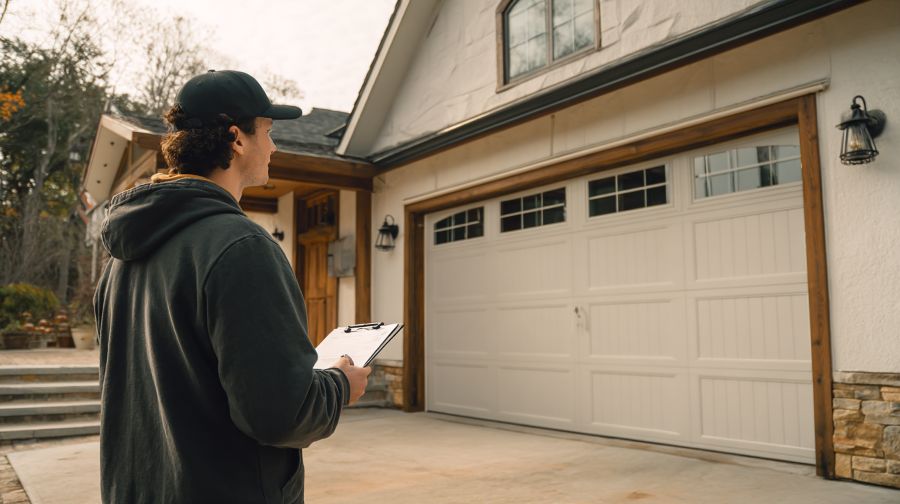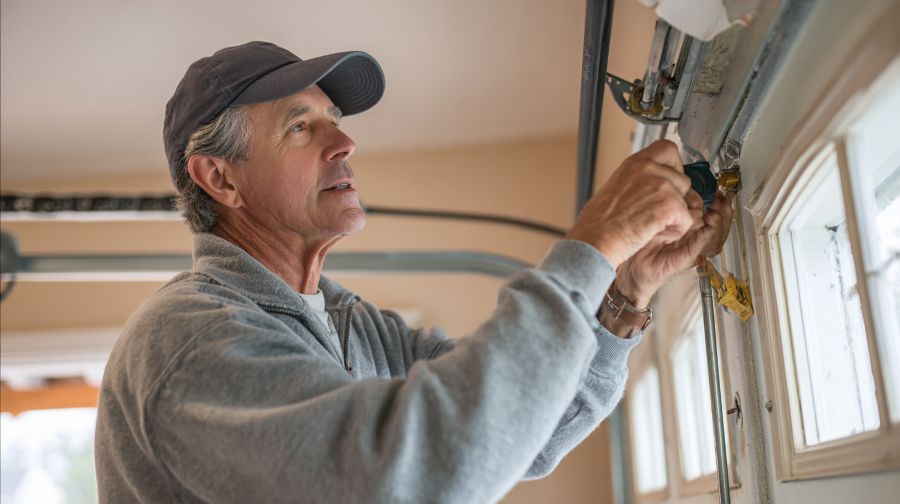Annual Garage Door Safety Checklist: Tests, Wear Signs & Safe DIY

A quiet garage door is like a polite refrigerator—nobody notices it until it screams. According to the U.S. Consumer Product Safety Commission, there were 48 child fatalities from opener entrapments reported over a decade before safety upgrades became mandatory—proof that small tests prevent big tragedies.
That sobering number underscores why a calm, methodical check once a year is more than housekeeping. It’s how you confirm that the counterbalance, sensors, and controls still behave like a team. Every test below can be done without special tools—and where a step crosses into “dangerous,” you’ll see a clear line in the sand.
Use this walkthrough to reset your door to “safe and smooth,” protect your opener from abuse, and spot the moments where a phone call to a pro is the safest tool in your kit.
Safety First: Setting the Stage for a Clean Check
Before touching anything, make the area predictable. Park vehicles outside. Keep pets and kids clear. Work in daylight or bright task lighting. Read your opener’s quick-start card so you know where the manual release cord is and how to re-engage it. You’re not “fixing” here—you’re evaluating, documenting, and making go/no-go decisions with confidence. A good checklist turns anxiety into a routine.
Section wrap: With the scene set and distractions gone, it’s time to assess the single most important indicator of system health: balance.
The Balance Test: The System’s Truth Serum
A well-balanced door feels nearly weightless by hand because the spring torque correctly counteracts the door’s mass. Pull the manual release so the opener disengages. Lift the door to knee height and let go; it should hover without rising or crashing. Repeat at mid-thigh and chest height. A door that drifts up is over-sprung; one that drifts down is under-sprung. Both conditions punish the opener’s gears and can become dangerous without warning.
Quick cues to note
- The door won’t stay at mid-travel without creeping.
- You feel sudden heaviness after the first foot of lift.
- The bottom seal crushes unevenly at the floor.
If the door fails any position test, stop using the opener and schedule service. The balance test is diagnostic, not a dare—springs store serious energy, and adjustment is not a homeowner task.
Section wrap: Balance sorts the “muscle.” Next, you confirm the “eyes” that protect people and pets are actually seeing straight.
Photo-Eye Alignment: The Little Sensors That Prevent Big Problems
Modern openers use infrared “photo-eyes” a few inches off the floor. If anything breaks the beam, the door should refuse to close or reverse immediately. Start by wiping each lens with a soft cloth—garage dust is sensor kryptonite. Check that the brackets are tight and both LEDs show solid “aligned” status per your opener’s manual. The centerlines of the eyes should face each other directly, not canted outward.
Alignment scan
- Height is consistent (typically 4–6 inches above the floor).
- Lenses are clean; no cobwebs or stored items are intruding.
- Wires are intact, not nicked or dangling.
Test function by waving a broom across the beam while closing: the door must reverse without hesitation. If the door ignores a broken beam, stop using it and call a pro—sensor bypasses or wiring damage are a safety emergency.
Section wrap: With the beam verified, you’ll validate the last line of defense when something’s in the way—the force-sensing reversal.
Auto-Reverse Test: Two Checks, One Promise
Your opener promises to stop and reverse when it meets resistance. You’ll verify that promise with two simple checks.
1) Contact reversal (“block” test)
Place a solid, flat object about the height of a typical test block under the door’s path. Close the door using the remote. On contact, it should reverse within a moment—no grinding, no pushing.
2) Non-contact reversal (photo-eye test)
Start the door closing, then interrupt the beam with your leg or a broom. The door should instantly reverse and return to the open position.
If either test fails, do not compensate by increasing force settings. That’s like turning up the music to ignore a knock in your engine. The fix is diagnosis—often recalibration or part replacement—not “more push.”
Section wrap: The controls passed their honesty test. Now turn attention to the parts that physically roll, hinge, and guide the door.

Roller & Hinge Health: Smooth Is Safe
Rollers should glide, not chatter. With the opener still disengaged, raise and lower the door by hand while listening along each track. Nylon or sealed-bearing rollers are quiet; clacking, wobble, or flat-spotted wheels point to wear. Hinges should sit flush to panels with all fasteners snug. Look for elongated screw holes, bent leaves, or cracked knuckles.
Avoid lubricants that collect grit; an appropriate light application on hinge pins and roller bearings (if serviceable) can quiet honest wear, but lubrication does not resurrect failed parts. Replace worn rollers and hinges in sets to keep movement uniform.
Section wrap: When the motion is glassy, your next concern is the heavy hardware holding the system together.
Cables, Drums & Bottom Brackets: High-Tension, Hands Off
The lift cables carry the door—treat them with respect. With the door closed, inspect for frays, rust blooms, or strands unwinding near the bottom bracket. Look up at the drums: cables should wrap neatly without stacking. Bottom brackets are the anchor points for cable tension; never remove or loosen them. Any cable damage is a stop sign, not a “keep an eye on it.”
If you notice uneven cable wrap, slack on one side, or a cable off a drum, contact a technician. These issues often ride alongside spring or bearing problems that require specialized tools and training.
Section wrap: With the cables checked visually, you’re standing near the most misunderstood component—the springs.
Springs: The Counterweights You Don’t Touch
Torsion springs above the door or extension springs along the tracks do the heavy lifting. You will only look for issues: gaps in a torsion spring coil that indicate a break; extension springs stretched unevenly; missing safety cables through extension springs; fresh rust, oily residue, or metal filings near end bearings.
Leave adjustment, replacement, or even “just one more twist” to a professional. Stored energy plus hand tools equals emergency room math. As one veteran installer puts it, “If a door can’t hold at mid-travel, the fix is in the spring math—not more muscle from the opener.”
Section wrap: The “muscle” looks intact? Then it’s time to confirm the structure that guides everything is square and true.
Tracks & Fasteners: Straight Lines, Tight Connections
Tracks should be plumb and parallel with consistent spacing. Sight down each run for kinks, bowing, or rub marks. Light, uniform clearance between rollers and track lips is your green light. Check lag screws at wall brackets and the opener’s header bracket; loose fasteners translate to rackety operation and shaved metal. Tighten within reason, avoiding crushed drywall or stripped studs.
Bent tracks or brackets are not candidates for persuasion with a pipe; deformation changes clearances at multiple points. Replacement is the safe choice.
Section wrap: With the guides confirmed, you can turn to the “brain”—the opener’s settings and its emergency options.

Opener Force, Travel & Manual Release: Smarts Over Strength
Re-engage the opener. Run a full open-close cycle. The door should start smoothly, stop without slamming, and avoid any bounce at the floor. If it “thinks” the door is shut before it reaches the floor, travel limits need recalibration; consult your model’s process. Force settings are last-resort guardrails—set them per the manual, not your gut.
Find the emergency release. Pull it and ensure you can move the door by hand, then re-engage per the manual. That chord is your way out during a power outage or control fault; knowing how it feels under calm conditions pays dividends later.
Section wrap: Controls verified, you can finish at the edges—the places where air, water, and pests bargain for entry.
Weatherstrips & Perimeter Seals: Quiet, Clean, and Dry
Examine the bottom seal for cracks or a flattened profile. Look at side and top seals for daylight, gaps, or rodent chew marks. Proper seals reduce grit on the tracks and keep temperature swings from stiffening moving parts. If seals are failing, replace them promptly; it’s an easy comfort upgrade that extends mechanical life.
Section wrap: The door is now evaluated from core mechanics to finishing touches. Next comes the hard boundary between “smart homeowner” and “smart to hire.”
Smart DIY vs. Call-a-Pro: Know the Line
Some tasks are safe, routine, and worth doing yourself. Others live on the wrong side of physics and you'll want to hire a professional garage door contractor.
Green-light DIY (You'll need the right garage door tools)
- Cleaning and aligning photo-eyes
- Testing auto-reverse (block and beam)
- Visual inspections of rollers, hinges, tracks, and cables
- Tightening accessible fasteners on brackets and track supports
- Replacing perimeter weatherstrips and bottom seals
- Clearing track debris and gently wiping rails
Hard-stop Pro Only
- Any spring work (torsion or extension)
- Cable replacement or re-wrapping on drums
- Track replacement or re-shaping
- Bearing, drum, or shaft service
- Force/travel issues that persist after balance is verified
- Electrical faults or opener logic board issues
A seasoned trainer in the trade says it plain: “If a tool slips and the door can move, you want a tech standing there—not your hand.”
Section wrap: With responsibilities split intelligently, you can turn annual checks into a simple ritual you’ll actually keep.
Make It Annual (and Predictable): A Simple Ritual That Sticks
Put a recurring reminder on your calendar—early spring works well, before heat or cold exaggerate minor issues. Keep a one-page checklist in the garage with dates and quick notes: balance pass/fail, sensor cleaning, reversal test outcome, noise changes, fasteners tightened, seals replaced. Photos of worn parts help you track trends over time and give a pro a head start if you need help.
Small habits prevent big repairs. A few minutes with a rag, hex driver, and keen eyes can erase months of grit and drift.
Section wrap: With a ritual in place, the final word is perspective—what a “safe, smooth” door feels like when everything’s right.
The Quiet Door Standard: What “Good” Actually Feels Like
When you’ve nailed safety and setup, the door feels light by hand. It starts and stops without drama, doesn’t bounce on landing, and refuses to close if anything breaks the beam. The opener hums instead of groaning. Your family can walk, scoot, and play without you flinching at every movement near the threshold.
That calm is the dividend of a checklist you can run without thinking—and the courage to say “this part is for a pro” when the stakes demand it.
One List, Safer Days
Safety lives in simple habits: a wipe of a sensor, a tug on a release cord, a balance check with steady hands. Doors fail in predictable ways; checks prevent those failures from becoming headlines. Keep the tests short, the boundaries firm, and the phone number of a trusted technician handy.
If a fifteen-minute ritual can trade uncertainty for quiet confidence and possibly even make over your garage door, what’s the single step you’ll take today to make your next open and close feel as safe as it should?
